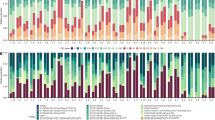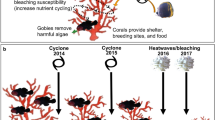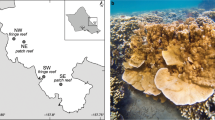Abstract
Reef-building corals are obligate, mutualistic symbioses of heterotrophic animals and phototrophic dinoflagellates (Symbiodinium spp.)1. Contrary to the earlier, widely accepted belief that corals harbour only one symbiont, we found that the ecologically dominant Caribbean corals Montastraea annularis and M. faveolata can act as hosts to dynamic, multi-species communities of Symbiodinium. Composition of these communities follows gradients of environmental irradiance, implying that physiological acclimatization2,3,4 is not the only mechanism by which corals cope with environmental heterogeneity. The importance of this diversity was underlined by analysis of a natural episode of coral bleaching. Patterns of bleaching could be explained by the preferential elimination of a symbiont associated with low irradiance from the brightest parts of its distribution. Comparative analyses of symbionts before and after bleaching from the same corals supported this interpretation, and suggested that some corals were protected from bleaching by hosting an additional symbiont that is more tolerant of high irradiance and temperature. This ‘natural experiment’ suggests that temporal and spatial variability can favour the coexistence of diverse symbionts within a host, despite the potential for destabilizing competition among them5,6.
This is a preview of subscription content, access via your institution
Access options
Subscribe to this journal
Receive 51 print issues and online access
$199.00 per year
only $3.90 per issue
Buy this article
- Purchase on Springer Link
- Instant access to full article PDF
Prices may be subject to local taxes which are calculated during checkout




Similar content being viewed by others
References
Trench, R. K. Microalgal-invertebrate symbioses: a review. Endocytobiosis Cell Res. 9, 135–175 (1993).
Falkowski, P. G., Jokiel, P. L. & Kinzie, R. A. II in Ecosystems of the World Vol. 25, Coral Reefs (ed. Dubinsky, Z.) 89–107 (Elsevier, Amsterdam, (1990)).
Brown, B. E. Coral bleaching: Causes and consequences. Coral Reefs (in the press).
Iglesias-Prieto, R. & Trench, R. K. Acclimation and adaptation to irradiance in symbiotic dinoflagellates. I. Responses of the photosynthetic unit to changes in photon flux density. Mar. Ecol. Prog. Ser. 113, 163–175 (1994).
Maynard Smith, J. & Szathmáry, E. The Major Transitions in Evolution(Oxford, Univ. Press, New York, (1995)).
Leigh, E. G. J & Rowell, T. E. The evolution of mutalism and other forms of harmony at various levels of biological organization. Ecologie 26, 131–158 (1995).
Rowan, R. & Knowlton, N. Intraspecific diversity and ecological zonation in coral–algal symbioses. Proc. Natl Acad. Sci. USA 92, 2850–2853 (1995).
Glynn, P. W. Coral reef bleaching: ecological perspectives. Coral Reefs 12, 1–17 (1993).
Williams, E. H. J & Bunkley-Williams, L. The world-wide coral reef bleaching cycle and related sources of coral mortality. Atoll Res. Bull. 335, 1–71 (1990).
Sandeman, I. M. in Mass Bleaching of Coral Reefs in the Caribbean: A Research Strategy (eds Ogden, J. & Wicklund, R.) (Natl. Undersea Res. Prog. Res. Rep. 88-2) 46–48 (NOAA, Washington DC, (1988)).
Edmunds, P. J. Evidence that reef-wide patterns of coral bleaching may be the result of the distribution of bleaching-susceptible clones. Mar. Biol. 121, 127–142 (1994).
Lesser, M. P., Stochaj, W. R., Tapley, D. W. & Shick, J. M. Bleaching in coral reef anthozoans: effects of irradiance, ultraviolet radiation, and temperature on the activities of protective enzymes against active oxygen. Coral Reefs 8, 225–232 (1990).
Fitt, W. K. & Warner, M. E. Bleaching patterns of four species of Caribbean reef corals. Biol. Bull. 189, 298–307 (1995).
Jokiel, P. L. & Coles, S. L. Response of Hawaiian and other Indo-Pacific reef corals to elevated temperature. Coral Reefs 8, 155–162 (1990).
CARICOMP. Studies on Caribbean coral bleaching, 1995.In Proc. 8th Int. Coral Reef Symp., Vol. 1(eds Lessios, H. A. & Macintyre, I. G.) 673–678 (Smithsonian Tropical Research Institute, Balboa, Panama, (1997)).
Lasker, H. R., Peters, E. C. & Coffroth, M. A. Bleaching of reef Coelenterates in the San Blas Islands, Panama. Coral Reefs 3, 183–190 (1984).
D'Croz, L. & Robertson, D. R. Coastal oceanographic conditions affecting coral reefs on both sides of the Isthmus of Panama.In Proc. 8th Int. Coral Reef Symp., Vol. 2(eds. Lessios, H. A. & Macintyre, I. G.) 2053–2058 (Smithsonian Tropical Research Institute, Balboa, Panama, (1997)).
Porter, J. W., Fitt, W. K., Spero, H. J., Rogers, C. S. & White, M. W. Bleaching in reef corals: Physiological and stable isotopic responses. Proc. Natl Acad. Sci. USA 86s, 9342–9346 (1989).
Gates, R. D. Seawater temperature and sublethal coral bleaching in Jamaica. Coral Reefs 8, 193–197 (1990).
Goreau, T. F. The ecology of Jamaican coral reefs I. Species composition and zonation. Ecology 40, 67–90 (1959).
Gleason, D. F. & Wellington, G. M. Ultraviolet radiation and coral bleaching. Nature 365, 836–838 (1993).
Dunbar, R. B. & Cole, J. E. Coral Records of Ocean-Atmosphere Variability (Clim. Glob. Change Prog. Spec. Rep. 10) (NOAA, Washington DC, (1993)).
Baker, A. C., Rowan, R. & Knowlton, N. Symbiosis ecology of two Caribbean acroporid corals.In Proc. 8th Int. Coral Reef Symp., Vol. 2(eds. Lessios, H. A. & Macintyre, I. G.) 1295–1300 (Smithsonian Tropical Research Institute, Balboa, Panama, (1997)).
Rowan, R. & Powers, D. A. Amolecular genetic classification of zooxanthellae and the evolution of animal-algal symbioses. Science 251, 1348–1351 (1991).
Buddemeier, R. W. & Fautin, D. G. Coral bleaching as an adaptive mechanism. Bioscience 43, 320–325 (1993).
Ware, J. R., Fautin, D. G. & Buddemeier, R. W. Patterns of coral bleaching: modelling the adaptive bleaching hypothesis. Ecol. Model. 84, 199–214 (1996).
Weil, E. & Knowlton, N. Amulticharacter analysis of the Caribbean coral Montastraea annularis (Ellis and Solander, 1786) and its two sibling species, M. faveolata (Ellis and Solander, 1786) and M. franksi Gregory, 1895). Bull. Mar. Sci. 55, 151–175 (1994).
Rowan, R. & Powers, D. A. The molecular genetic identification of symbiotic dinoflagellates (zooxanthellae). Mar. Ecol. Prog. Ser. 71, 65–73 (1991).
Jeffrey, S. W. & Haxo, F. T. Photosynthetic pigments of symbiotic dinoflagellates (zooxanthellae) from corals and clams. Biol. Bull. 135, 149–165 (1968).
Reynolds, R. W. & Smith, T. M. Improved global sea surface temperature analyses. J. Clim. 7, 929–948 (1994).
Acknowledgements
We thank R. Robertson for alerting us to the bleaching event; J. Maté and E. Gomez for assistance; K. Kaufmann for help with temperature records; R. W. Buddemeier, J. B. C. Jackson and W.Toller for comments on the manuscript; and the Government of Panama and the Kuna nation for allowing access to the site and collecting. This research was supported by the Smithsonian Institution, the Andrew W. Mellon Foundation, the Office of Naval Research, the NIH and NOAA.
Author information
Authors and Affiliations
Corresponding author
Rights and permissions
About this article
Cite this article
Rowan, R., Knowlton, N., Baker, A. et al. Landscape ecology of algal symbionts creates variation in episodes of coral bleaching. Nature 388, 265–269 (1997). https://doi.org/10.1038/40843
Received:
Accepted:
Issue Date:
DOI: https://doi.org/10.1038/40843
This article is cited by
-
Juvenile octocorals acquire similar algal symbiont assemblages across depths
Coral Reefs (2024)
-
The role of background algal symbionts as drivers of shuffling to thermotolerant Symbiodiniaceae following bleaching in three Caribbean coral species
Coral Reefs (2023)
-
From polyps to pixels: understanding coral reef resilience to local and global change across scales
Landscape Ecology (2023)
-
Symbiont-mediated tradeoffs between growth and heat tolerance are modulated by light and temperature in the coral Montipora capitata
Coral Reefs (2023)
-
Photosynthetic usable energy explains vertical patterns of biodiversity in zooxanthellate corals
Scientific Reports (2022)
Comments
By submitting a comment you agree to abide by our Terms and Community Guidelines. If you find something abusive or that does not comply with our terms or guidelines please flag it as inappropriate.



